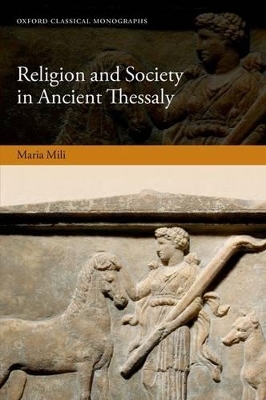
Religion and Society in Ancient Thessaly
Oxford University Press (Verlag)
978-0-19-871801-7 (ISBN)
The fertile plains of the ancient Greek region of Thessaly stretch south from the shadow of Mount Olympus. Thessaly's numerous small cities were home to some of the richest men in Greece, their fabulous wealth counted in innumerable flocks and slaves. It had a strict oligarchic government and a reputation for indulgence and witchcraft, but also a dominant position between Olympus and Delphi, and a claim to some of the greatest Greek heroes, such as Achilles himself. It can be viewed as both the cradle of many aspects of Greek civilization and as a challenge to the dominant image of ancient Greece as moderate, rational, and democratic.
Religion and Society in Ancient Thessaly explores the issues of regionalism in ancient Greek religion and the relationship between religion and society, as well as the problem of thinking about these matters through particular bodies of evidence. It discusses in depth the importance of citizenship and of other group-identities in Thessaly, and the relationship between cult activity and political and social organization. The volume investigates the Thessalian particularities of the evidence and the role of religion in giving the inhabitants of this land a sense of their identity and place in the wider Greek world, as well as the role of Thessaly in the ancients' and moderns' understanding of Greekness.
Maria Mili has studied history and archaeology at the Aristotle University of Thessaloniki, the University of Edinburgh, and the University of Oxford. She lives in Athens and Crete.
List of Maps ; Abbreviations ; 1. Three Questions for a Regional Study of Religion ; 1.1. Regional Studies of Religion: Questions, Structures, and Titles ; 1.2. Defining the Unit of Analysis: Polis Religion in Ethne? ; 1.3. Describing Difference ; 1.4. Assessing the Evidence ; 1.4 1a. Inscribed Sculpted Dedications ; 1.4 1b. Other Dedications ; 1.4 2. Varieties of Religious Space ; 1.5. At the Limits of the Evidence: The Case of Hera ; 2. Oligarchic Constitution and Religion in the Thessalian Poleis ; 2.1 Religion, Oligarchic Citizenship and the Ethnos ; 2.2 The Gene and Phratries versus Phylai Controversy ; 2.3 Citizenship in Thessalian Poleis ; 2.3.1 Political Participation and Citizenship ; 2.3.2 Politeia, Politeuma, and Astos in Thessalian Inscriptions ; 2.4 The Second Sex: Women in Thessalian Society and World View ; 2.5 Models of Oligarchic Constitution and Religion in the Thessalian Poleis ; 3. Polis Cults ; 3.1 Questions and Definitions ; 3.2 Cults on the Acropolis ; 3.2.1 Guarding the City: The Cult of Athena Polias ; 3.2.2 Killing for the City: The Problem of Zeus Thaulios ; 3.2.3 Acropolis' Views of the Countryside: Dionysus, Demeter, and Heracles. ; 3.3 Cults in the Agora ; 3.3.1 Cults in the Agora(s) of Atrax: Themis, Athena, and Others? ; 3.3.2 Hestia: Private Claims at the Common Hearth? ; 3.3.3 Whose Profit? The Cult of Apollo Kerdoos ; 3.4 Around the Walls ; 3.4.1 The Cult of Asclepius ; 3.4.2 On the Road: The Cult of Ennodia ; 3.5 Conclusions: Polis Cults of the 'Thessalian Polis' ; 4. Thessaly through the Kaleidoscope ; 4.1 The Thessalian Space-time ; 4.2 Mythical Structures of Thessalian Geography ; 4.3 Historical Perspectives: New People, New Gods, New Cities ; 5. Panthessalianism and Religion ; 5.1 Thessalian Unity and 'Ethnos Religion' ; 5.2 Who Were the Thessalians? ; 5.3 The Cult of Athena Itonia and the Problem of Beginnings ; 5.4 The Cult of Poseidon Petraios and the Festival Peloria: Different Ways of Being Thessalian ; 5.5 Thessaly and Delphi ; 5.6 Cults of the Thessalians and Their Syngeneis ; 5.7 Panthessalianism and Religion: Understanding Variety ; 6. The Land Rich in Herbs ; 6.1 Welcome to Thessaly: Meadows, Horses, Parties, and Herbs! ; 6.2 Thessalian Visions of the Underworld ; 6.3 Priests, Charlatans, and Charismatics ; 6.4 The Enchantment of Thessaly ; Epilogue ; Appendix 1: Thessalian inscribed dedications ; Appendix 2: Site-summaries of Thessalian sanctuaries ; Appendix 3: Catalogue of social/religious groups attested in the epigraphic record ; Bibliography ; Subject Index ; Select Index of Sources
| Erscheint lt. Verlag | 27.11.2014 |
|---|---|
| Reihe/Serie | Oxford Classical Monographs |
| Verlagsort | Oxford |
| Sprache | englisch |
| Maße | 162 x 237 mm |
| Gewicht | 822 g |
| Themenwelt | Geschichte ► Allgemeine Geschichte ► Vor- und Frühgeschichte |
| Geschichte ► Allgemeine Geschichte ► Altertum / Antike | |
| Geisteswissenschaften ► Geschichte ► Regional- / Ländergeschichte | |
| Geschichte ► Teilgebiete der Geschichte ► Kulturgeschichte | |
| Geschichte ► Teilgebiete der Geschichte ► Religionsgeschichte | |
| Geschichte ► Teilgebiete der Geschichte ► Sozialgeschichte | |
| Sozialwissenschaften ► Politik / Verwaltung ► Staat / Verwaltung | |
| Sozialwissenschaften ► Soziologie | |
| ISBN-10 | 0-19-871801-2 / 0198718012 |
| ISBN-13 | 978-0-19-871801-7 / 9780198718017 |
| Zustand | Neuware |
| Haben Sie eine Frage zum Produkt? |
aus dem Bereich


